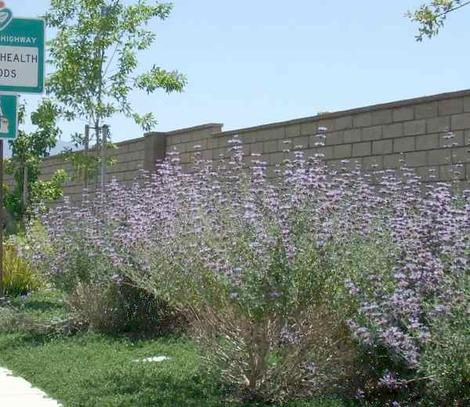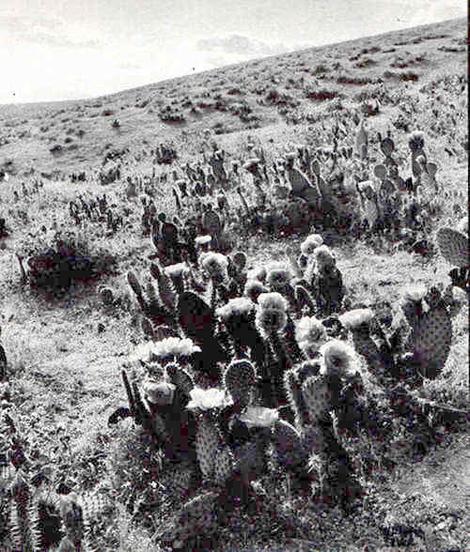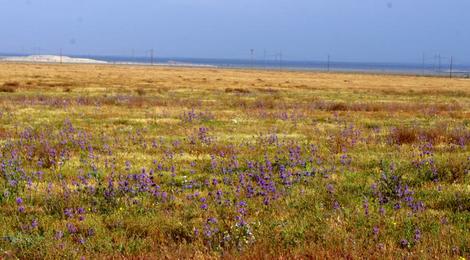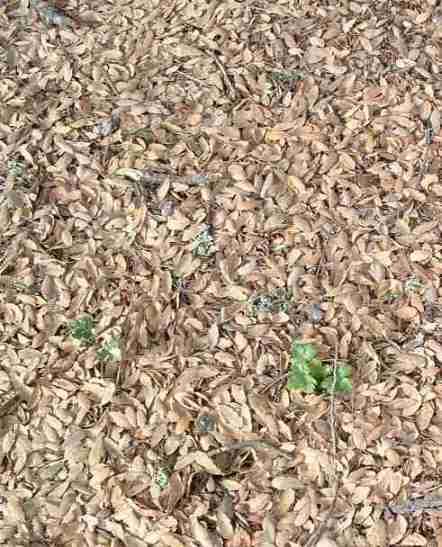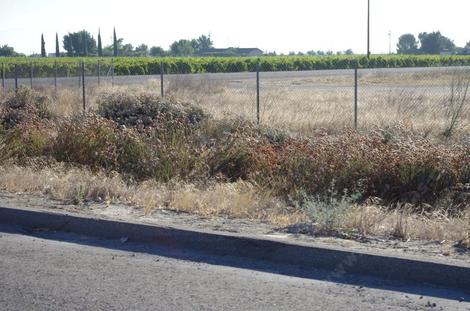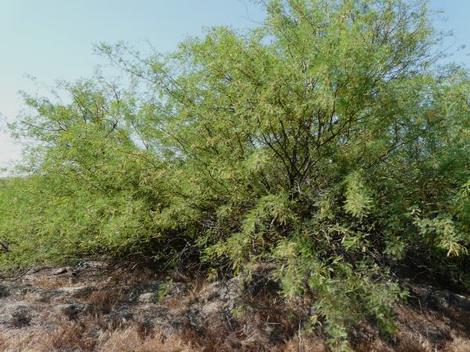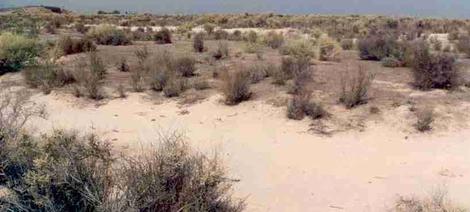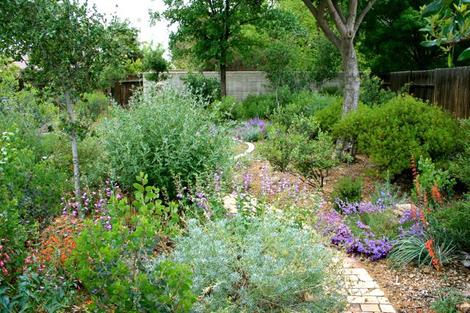A California Native Plant Garden in the San Joaquin Valley of Central California
A customer emailed us a few weeks ago, and asked about a list of plants that could be used in a native plant garden for the San Joaquin Valley; so here it is, somewhat expanded.If you calculate just by the rain gauge totals, average 5 or so inches per year, the San Joaquin Valley area actually is a desert. The soils are alkaline, and some areas have high levels of salt in the soil.
Rainfall can be increased and salt in the soil decreased by planting trees, and shrubs anywhere and everywhere.
Trees produce the most "rainfall", and shrubs are next. How
Rainfall is Increased by Planting Trees and Shrubs.
Trees Create Rain.
Trees, and shrubs release water vapor (transpiration) from all parts,
mostly through the leaf pores (stomata) and some of that water,
condenses back into liquid water, drops back on and into the plant, and
some extra rolls off the plant and onto/into the soil/mulch. This is a
different form of rain, but it is still rain!
Plants Catch Water From the Tule
Fog, and More Rain is Produced
For several months every year, the San Joaquin Valley is covered by the
tule fog, which hangs so low, and is so thick, that when you are
driving a car, you cannot see the white line in the middle of the road,
barely see the road itself, or even the edge of the road! Every
24 hours, the water that is in tiny droplets in the tule fog, contacts
the leaves of the trees and shrubs and drips off the leaves and onto
the ground. All together, trees, and shrubs, can significantly increase
effective rainfall in a region. Generally, the taller and wider the
tree, the more moisture it catches, and the more "rain" it produces! It
also catches nutrients (ammonium, sulfate, nitrate) in the air, via the
water vapor, that helps to acidify an alkaline soil. More "rain" from
the plants-and-tule fog combination! This "rain" also may contain lower
levels of alkali salts than the irrigation water!
How Planting Trees Helps the Land
Deep-rooted trees and shrubs: allow the soil to hold more moisture,
increase nutrients in the soil, decrease pH (make alkaline soils more
acidic), decrease soil EC (electrical conductivity) and decrease sodium
levels in the soil. Neighboring trees outermost leaves should touch
each other (canopy closure) for best results.
Vegetation Change = Rainfall Change
Researchers have discovered, much to their dismay, that when trees, are
removed from an area, the rainfall drops in half!! and soil alkalinity
increases! This means, if the measured rainfall in a region with the
natural component of trees and shrubs, was 5 inches/year, in reality it
was actually closer to 10 inches/year, adding in the water that drips
from trees and shrubs (which is not caught in a rain gauge). If trees
were then removed the rainfall would go from 10 inches/year down to
truly 5 inches/year. Trees and shrubs make rain, and decrease alkali
salts in soil!
Mulch Saves Water Several Ways
Mulch of plant material, set on top of the ground, not tilled in, about 2-4 inches thick, helps to keep water from leaving the ground and going back up into the air, by creating an inversion layer, that keeps the water from wicking to the surface, and evaporating (soil surface is not exposed to air), and keeping the soil cool. The mulch also absorbs water and that water is then stored in the mulch itself. Over time, the mulch is changed by tiny animals and plants living in the soil, into natural humus (the natural form of those bags of "soil conditioner" you pay so much for at the garden center!). Humus changes the soil texture in such a way, as to make the soil more porous, aerated, improves soil drainage, reduces soil alkalinity, and the humus particles also absorb water.Living Plants Save Water
Trees and shrubs covering the ground at all times, save water. The leaves that drop from these plants form a natural mulch, that is converted by soil organisms into nutrients for the plants, and all the soil microorganisms associated with the plants.
These associated microorganisms expand the root systems of the trees and shrubs up to one thousand times, store water, buffer the pH (that is a good thing!), provide a partial immune system for the plants, and shunt water between the trees and shrubs. Researchers have estimated that there are 3 million soil organisms per cubic meter (3 feet by 3 feet by 3 feet)
that are constantly working to improve soil.
A Short List of Dryland Plants (Mostly) That Should Grow Well in the San Joaquin Valley of California
Below is a list of trees, shrubs, and herbs you can grow if you have access to extra water for irrigation, or a list of California native plants you can grow if you do not have access to lots of water, but just a little to get them established. Some of the plants fix nitrogen, and add this essential nutrient to the other plants and the soil.Best Planting Practices
For best results, set out plants in groups of five or more, so you have a little "community" of plants, and they will support each other. To set out the plant, dig a hole, set in the plant, cover with dirt, water well, and then cover with mulch .For best results, Do Not Add Amendments, or Fertilizer.
Best mulch for each one of the remaining plants is two rocks, same size as above, set next to the west and south side of the plant. Beyond that a 2 ft. radius circle of living small annual plants, for example, lupine (Lupinus nanus), tidy tips (Layia platyglossa), and goldfields (Lasthenia glabrata).
Mostly Drought Tolerant California Native Plants that grow in neutral to alkaline/saline soils.
Honey Mesquite, Prosopis glandulosa (fixes nitrogen)
Tornillo, Prosopis pubescens (fixes nitrogen)
Quail Bush, Atriplex lentiformis, 1921, Firebaugh
Alkali Salt Bush, Atriplex polycarpa
Palo Verde, Cercidium floridum (fixes nitrogen)
Wand Buckwheat, Eriogonum nudum var. pubiflorum
Yellow Daisy Gumplant, Grindelia hirsutula
Jojoba, Simmondsia chinensis
Indian Rice Grass, Achnatherum hymenoides
Big Sagebrush, Artemisia tridentata
Narrow-Leaved Milkweed, Asclepias fascicularis (may need more irrigation)
Four-Wing Salt Bush, Atriplex canescens
Salt Bush, Atriplex confertifolia
Rabbit Brush, Chrysothamnus nauseosus
Salt Grass, Distichlis spicata
Incienso, Encelia farinosa
Mormon Tea, Ephedra californica
Creosote Bush, Larrea tridentata
Pink Flowered Bush Mallow, Malacothamnus fasciculatus
Buffalo Berry, Sheperdia argentea (may need some irrigation)(fixes nitrogen)
Desert Needle Grass, Stipa speciosa
Desert Grape, Vitis girdiana (needs regular water)
A List of Plants that Historically, Grew in the San Joaquin Valley of California
Historical California Native Plants (need some form of irrigation, to get started, and higher / lower maintenance watering thereafter, depending on the species). This is just a smattering of plants to get you started. Many can tolerate alkaline soils, (we listed those below) and as more plants, trees especially, are grown, the alkalinity should decrease, and then your plant list can be expanded with a wider variety of species.Valley Oak Tree, Quercus lobata, 1950, Parlier, Hanford, Riverdale, Lemoore
Ash Tree, Fraxinus latifolia, 1961, Pinedale, and around Fresno earlier
Fremont Cottonwood Tree, Populus fremontii, 1910- Coalinga, also 2011- Huron
Elderberry, Sambucus mexicana, 1954- Centerville, also 2011- Huron
Narrow-Leaved Willow Tree, Salix exigua, 1955, Kerman (will tolerate alkali)
Goodding's Black Willow Tree, Salix gooddingii, 1965, Kerman (will tolerate alkali)
Arroyo Willow Tree, Salix lasiolepis, 1931, Centerville California
Button Willow Tree, Cephalanthus occidentalis, 1928, Fresno;
California Blackberry Bush, Rubus ursinus, 1954, Centerville
Salt Grass, Distichlis spicata, 1950, Hanford (tolerates alkali)
Grass-Leaved Goldenrod, Euthamia occidentalis, 1964, Corcoran
Alkali Rye Grass, Leymus triticoides, 1919, Tranquility (tolerates alkali)
Caespitose Evening Primrose, Oenothera caespitosa ssp. deltoides 1919, Fresno
Fleabane Daisy, Pluchea sericea, 1948, Stratford, (tolerates alkali)
Tule, Schoenoplectus acutus var. occidentalis (Scirpus acutus var. occidentalis), 1956, Tulare Lake (will tolerate alkali)
Southern Cattail, Typha domingensis, 1949, Sanger (best on edge of small pond)
Broad-Leaved Cattail, Typha latifolia, 1949, Sanger (best on edge of small pond) (tolerates alkali)
Bur-Marigold, Bidens laevis, 1915, Hanford
Lippia groundcover, Phyla nodiflora var. incisa, 1955, between Kerman & Mendota (tolerates alkali)
Native plants within the UC Aboretum All Stars. These are mostly Valley garden tolerant plants.
Achillea millefolium
Aquilegia eximia
Aristolochia californica
Berberis aquifolium "Compacta"
Bouteloua gracilis
Calycanthus occidentalis
Carpenteria californica
Ceanothus x pallidus "Marie Simon"
Ceanothus 'Ray Hartman'
Ceanothus "Concha"
Ceanothus maritimus "Valley Violet"
Cercis occidentalis
Cercocarpus betuloides var. blancheae (alnifolia)
Epilobium canum
Erigeron "Wayne Roderick"
Eriogonum giganteum
Festuca californica
Heteromeles arbutifolia
Heuchera maxima
Isomeris arborea
Lessingia filaginifolia var. californica "Silver Carpet"
Muhlenbergia rigens
Penstemon heterophyllus "Margarita BOP"
Quercus lobata
Ribes malvaceum
Ribes aureum
Ribes viburnifolium
Salvia apiana
Salvia spathacea
Salvia clevelandii 'Winnifred Gilman'
Solidago californica "Cascade Creek"
Viguiera parishii
Woodwardia fimbriata
